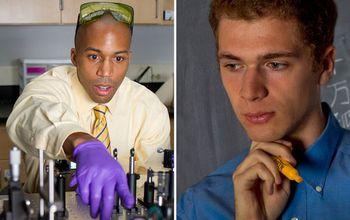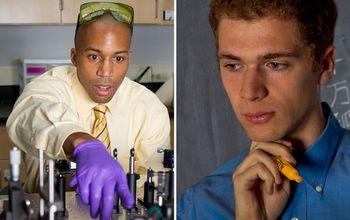
Credit: Georgia Institute of Technology (left); Denise Applewhite, Princeton University (right)
The National Science Foundation (NSF) today recognized Baratunde "Bara" A. Cola of the Georgia Institute of Technology and John V. Pardon of Princeton University with the nation's highest honor for early career scientists and engineers, the Alan T. Waterman Award. This marks only the second time in the award's 42-year history that NSF selected two recipients in the same year.
Bestowed annually, the Waterman Award recognizes outstanding researchers age 35 and under in NSF-supported fields of science and engineering.
In addition to a medal, awardees each receive a $1 million, five-year grant for research in their chosen field of study.
"We are seeing the significant impact of their research very early in the careers of these awardees," said NSF Director France Córdova. "That is the most exciting aspect of the Waterman Award, which recognizes early career achievement. They have creatively tackled longstanding scientific challenges, and we look forward to what they will do next."
Baratunde "Bara" A. Cola
Cola pioneered new engineering methods and materials to control light and heat in electronics at the nanoscale. He serves as an associate professor at Georgia Tech's George W. Woodruff School of Mechanical Engineering.
In 2015, Cola and his team were the first to overcome more than 40 years of research challenges to create a device called an optical rectenna, which turns light into direct current more efficiently than today's technology. The device could lead to highly efficient solar cells with the potential to power new generations of cell phones, laptops, satellites and drones.
The technology uses carbon nanotubes that act as tiny antennas to capture light. Light is then converted into direct current by miniature, nanotechnology-enabled mechanisms called rectifier diodes. The research has the potential to double solar cell efficiency at one-tenth the cost, according to Cola.
"Ultimately, we see the Waterman as fueling the final leg of our long-term effort to be the first to truly bring transformational applications of carbon nanotubes to the market," Cola said. "As of now, we know that there will be a substantial investment in engineering another breakthrough in carbon nanotube optical rectenna science."
Cola also works to commercialize other novel nanotechnology-based innovations. In 2015, he participated in NSF Innovation Corps (I-Corps) at Georgia Tech, a program that immerses scientists and engineers in entrepreneurial training, teaching them to look beyond the lab and consider the commercial potential or broader impacts of their research. I-Corps participants interview prospective customers and identify market needs for federally funded innovations.
In addition, Cola and colleagues were responsible for engineering breakthroughs, including the first thermally conductive amorphous polymer, the first practical electrochemical cell for generating electricity from waste heat and the first evidence of thermal energy conduction by surface polaritons.
Cola, 35, is the founder of Carbice Nanotechnologies, Inc., a company that uses a carbon nanotube-material to remove heat from computer chip testing stations, allowing for faster and cheaper testing of chips during production. The technology could eventually result in smaller, faster, more powerful computer chips for use in everything from smartphones to supercomputers. Carbice Nanotechnologies received support from NSF's Small Business Innovation Research program.
He also is co-founder of the NSF-funded Academic and Research Leadership Network, a group of more than 300 Ph.D. engineering researchers from minority groups underrepresented in academia, industry and government laboratories.
John V. Pardon
Pardon is a Clay Research Fellow and professor of mathematics at Princeton University. His research focuses on geometry and topology, the study of properties of shapes that are unaffected by deformations, such as stretching or twisting. He is known for solving problems that stumped other mathematicians for decades and generating solutions that provide new tools for geometric analysis.
In 2013, Pardon published a solution to the Hilbert-Smith conjecture, a mathematical proposition involving the actions of groups of "manifolds" in three dimensions. Manifolds include spheres and doughnut-shaped objects.
The conjecture originates from one of the 23 problems published in 1900 by German mathematician David Hilbert, which helped guide the course of 20th century mathematics. American topologist Paul Althaus Smith proposed a stronger version of the problem in 1941. This problem has connections to many other areas of mathematics and physics. Pardon's publication was notable for proving this longstanding conjecture, a major achievement in mathematics.
Prior to that publication, as a senior undergraduate at Princeton, Pardon answered a question posed in 1983 by Russian mathematician Mikhail Gromov regarding "knots," mathematical structures that resemble physical knots, but are closed, instead of having any ends.
Gromov's question involved a special class of knots called "torus knots." He asked whether these knots could be tied without altering or distorting their topology. Pardon figured out a way to use the distortion between two properties of knots — their intrinsic and extrinsic distances — to control their topology. He showed that torus knots are limited by their geometric properties, and can be tied without altering their topology.
Pardon's solution has important applications in fluid dynamics and electrodynamics, calculating forces involved in aircraft movement, predicting weather patterns, determining the flow of liquids through water treatment plant pipelines, determining the flow of electrical charges, and more.
Pardon, who received his doctorate in mathematics in 2015 from Stanford University, has been a full professor at Princeton since fall 2016. Among other awards, Pardon earned a National Science Foundation Graduate Research Fellowship to support his graduate studies at Stanford. As of October last year, Pardon had published 11 papers on such subjects as contact homology, virtual fundamental cycles, the distortion of knots, algebraic varieties, and the carpenter's rule problem.
###
Media Contact
Bobbie Mixon
[email protected]
@NSF
http://www.nsf.gov





